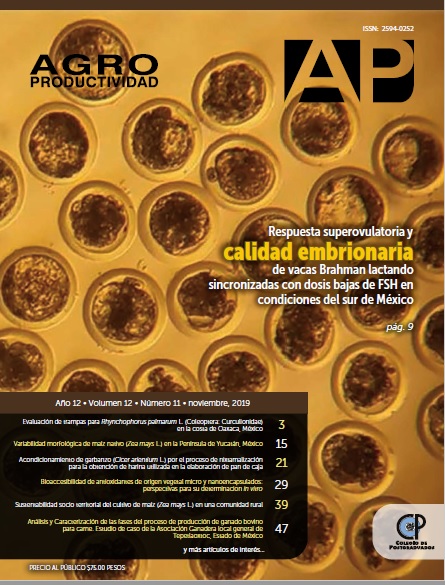Sistema acuapónico con humedal subsuperficial para producción de carpa (Cyprinus carpio L.), fresa (Fragaria x ananassa (Duchesne ex Weston) y canola (Brassica napus L.)
Main Article Content
Keywords
carp, hydroponics, strawberry, canola.
Abstract
Objective: a greenhouse pilot aquaponic system was installed, operated, and evaluated to produce carps-strawberry-canola.
Design / methodology / approach: the proposed aquaponics system was made of 4 modules: 1) module for the production of carp (Cyprinus Carpio comunis), 2) hydroponic module, deep flow type for the production of duckweed (Lemna minor L.) used to feed the carps, 3) hydroponic module for the strawberry production (Fragaria × ananassa), 4) hydroponic module with substrate (medium gravel) for the canola production (Brassica napus). The carps (Cyprinus carpio) had an average weight of 0.92 g at the beginning of the study (July 2018), the density was 500 carps/ 0.7 m3 of water. From September to December, a sample of 5% was taken to quantify their growth (length and weight) employing a Vernier, and a triple beam balance (OHAUS®). The carps were fed only with duckweed (Lemna minor L.). The carps were fed daily with 1.5% of duckweed as fresh matter concerning the average live weight of the 500 carps. Module 2 had an area of ??0.26 m2. The dry matter of duckweed was quantified using a PVC cylinder that had an area of ??0.010 m2, and then the fresh sample was weighed and dried at 105º C until constant weight. Module 3 (0.42 m2) had 23 plants in a vegetative state, the growth of 5 plants was evaluated by measuring the size of the root (cm), the height of the plant (cm), the length and width of the leaves (cm) and the foliar area (cm2). Module 4 had 0.42 m2, canola seed was sown at a density of 1.2 g/m2 that represented 185 seedlings. The growth of 9 plants was evaluated by measuring the same variables of strawberry plants.
Results: in module 1, an average weight per carp of 17.7 g was obtained, representing an average weight increase of 16.8 g in the period from September to December. Module 2 produced 12 kg of duckweed in a fresh basis with 5.6% of dry matter. duckweed production was maintained using the nutrients from the effluent of module 1. In module 3, it was observed that strawberry plants presented an increase of 2.5 g in the fresh weight, 1 cm in root size, 0.9 cm in plant height, 0.2 cm in leaf length, 0.2 cm in leaf width and 0.4 cm2 in the leaf area. In module 4, there was an increase of 8.1 g in plant height, 0.2 cm in the leaf length, 0.2 cm in the leaf width and 0.1 cm2 in the leaf area.
Limitations of the study/ implications: for the canola crop, only results of the vegetative growth were reported. For the carps, only three months were reported. However, there was evidence of the feasibility of the system.
Findings/ Conclusions: an aquaponic system was installed, operated, and evaluated to produce carps-strawberry-canola. The duckweed was the only source of dry matter for carps. The effluent from the carp module provided nutrients for strawberry growth, bearing fruits of the right color. Canola plants developed adequately, although they had a purple color on the leaves, indicating a possible phosphorus deficiency.

